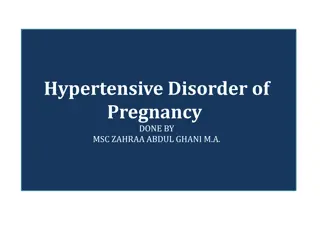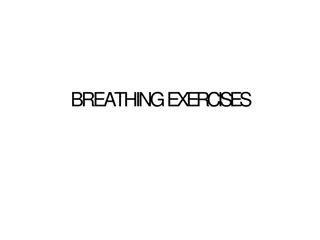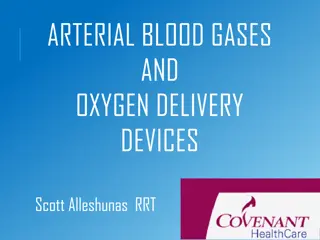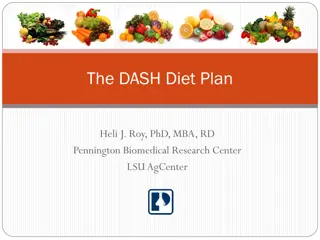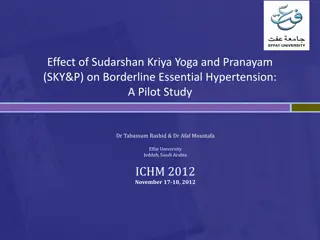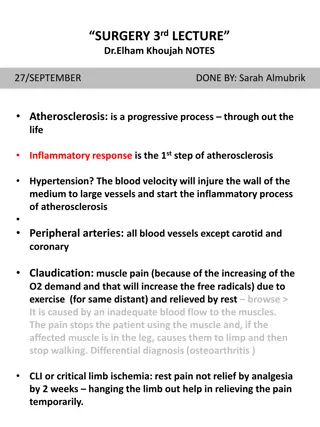Step On Up: Peripheral Arterial Disease (PAD)
Peripheral Arterial Disease (PAD), a condition caused by reduced blood flow in the legs or arms. Understand the symptoms, signs, importance of early detection, and who is at risk. Find out about the tests for PAD.
0 views • 18 slides
Comprehensive Guidelines for Hypertension Management in Canada 2020
The Hypertension Canada's 2020 Comprehensive Guidelines provide insights on prevention, diagnosis, risk assessment, and treatment of hypertension in adults and children. The guidelines emphasize standardized blood pressure measurement, risk factors, and the use of out-of-office monitoring for accura
2 views • 62 slides
Echocardiographic Assessment of Pulmonary Arterial Hypertension (PAH) Overview
Echocardiographic assessment plays a crucial role in the diagnosis, management, and prognostic evaluation of pulmonary arterial hypertension (PAH). This condition is characterized by elevated mean pulmonary arterial pressure and pulmonary vascular resistance, leading to various clinical features suc
6 views • 43 slides
Pulmonary Circulation and V/Q Ratio in Respiratory Physiology
Explore the high-pressure and low-pressure circulations supplying the lungs, the concept of physiological shunt in pulmonary circulation, different lung zones based on blood flow, V/Q ratio and its clinical significance, and abnormal V/Q ratio patterns. Delve into the role of pulmonary circulations
12 views • 28 slides
Hypertension: Causes, Consequences, and Prevention
Hypertension, or high blood pressure, has emerged as a leading cause of premature death and disability globally. This chronic condition affects a significant portion of the adult population, with prevalence increasing notably with age. Uncontrolled hypertension can lead to severe health complication
1 views • 8 slides
Pulmonary Circulation and Its Importance in Respiratory Physiology
Pulmonary circulation, as explained by Professor Narsingh Verma, plays a crucial role in the respiratory system, showcasing distinct differences from systemic circulation. The low pressure and resistance in pulmonary circulation allow for optimal gas exchange at the alveolocapillary membrane. Variou
1 views • 30 slides
Comprehensive Overview of Pulmonary Function Tests (PFTs)
Pulmonary Function Tests (PFTs) are vital for assessing pulmonary gas exchange through ventilation, diffusion, and lung perfusion. These tests include measurements of lung volume, airway patency, gas exchange efficacy, and pulmonary blood flow. PFTs offer benefits in diagnosing dyspnea, monitoring d
0 views • 14 slides
Hypertension: Types, Pathogenesis, and Management
The article discusses the physiological basis, types, pathogenesis, and genetic predisposition of hypertension. It explains the revision of terminology related to blood pressure and the calculation of mean arterial pressure. Secondary hypertension, causes, and mean arterial pressure determination ar
0 views • 29 slides
Hypertensive Disorders of Pregnancy
Hypertensive disorders of pregnancy, including gestational hypertension and preeclampsia, pose significant risks to both the mother and fetus. Gestational hypertension is characterized by elevated blood pressure after 20 weeks of gestation, while preeclampsia involves hypertension with end-organ man
1 views • 22 slides
Hypertension: Causes, Classification, and Complications
Hypertension, a common yet serious health issue, is explored in detail in this lecture. The etiology, risk factors, and complications of hypertension are discussed, along with the classification into primary, secondary, benign, and malignant hypertension. The lecture also covers causes of secondary
1 views • 13 slides
The Importance of Breathing Exercises in Respiratory Management
Breathing exercises, also known as ventilatory training, play a crucial role in improving pulmonary status, enhancing endurance, and increasing overall functionality in daily activities. These exercises help retrain respiratory muscles, improve ventilation, reduce breathing effort, enhance gas excha
0 views • 32 slides
Managing Speeding Opportunities on Arterial Streets Using Traffic Signals
The study discusses strategies to limit speeding opportunities on arterial streets, particularly focusing on the impact of traffic signal coordination on reducing speeding incidents. Results from simulation tests and real-world observations are presented, highlighting the effectiveness of signal con
0 views • 16 slides
Pregnancy-Induced Hypertension and Gestational Hypertension
Pregnancy-induced hypertension, also known as gestational hypertension, can pose risks to both the mother and the fetus. This condition, characterized by high blood pressure during pregnancy, can lead to complications such as preeclampsia. Learn about the causes, symptoms, and differences between th
0 views • 24 slides
Management of Severe Hypertension in Maternal Health
Learn about the critical management of severe hypertension in maternal health, including the acute control of hypertension, risks of maternal deaths, guidelines for treating severe hypertension, medication recommendations, and essential tips for optimal blood pressure control during pregnancy.
0 views • 6 slides
Pulmonary Hydrotherapy: Innovation in Exercise for COPD Patients
Pulmonary hydrotherapy is being explored as a safe and effective form of exercise for COPD patients, challenging previous beliefs about water-based activities. South Tees Pulmonary Rehabilitation Service is examining the benefits of hydrotherapy in improving exercise capacity and quality of life, ba
1 views • 10 slides
Hypertension: Causes, Symptoms, and Management
Blood pressure is the force of blood against the artery walls. Hypertension, or high blood pressure, can lead to serious health risks like heart disease, stroke, and kidney failure. Primary hypertension may be caused by factors like heredity, obesity, and stress, while secondary hypertension can be
2 views • 20 slides
Hypertension Diagnosis and Management in a Case Study
Mrs. Esraa, a 41-year-old architect, presents for a follow-up in a clinic. Despite being euthyroid and generally fit, her blood pressure is high at 146/88 mmHg. Proper blood pressure measurement is emphasized, along with considerations for diagnosing hypertension and initiating treatment. The discus
0 views • 114 slides
Portal Vein Imaging Techniques and Anomalies Overview
Portal vein imaging is crucial for evaluating conditions affecting the abdominal part of the gastrointestinal tract. Techniques such as spleno-portography and CT triphasic contrast imaging are used to visualize the portal vein and diagnose anomalies like portal-systemic collaterals and porto-systemi
4 views • 7 slides
Overview of the Cardiovascular System and Arterial Blood Vessels
The cardiovascular system includes the heart, arteries, veins, and capillaries, responsible for the transport of blood and lymph throughout the body. Arterial blood vessels are classified based on diameter into large (elastic) arteries, medium (muscular) arteries, and arterioles. The arterial wall c
0 views • 13 slides
Insights from the 26th European Meeting on Hypertension and Cardiovascular Protection
The SLEPT trial presented at the 26th European Meeting on Hypertension and Cardiovascular Protection in Paris explored the role of a sleep intervention in improving blood pressure. While the trial showed enhancements in sleep quality and psychosocial health, the primary outcome of better blood press
0 views • 7 slides
Management of Eclampsia and Pre-eclampsia in Pregnancy: Anesthesia Considerations by Dr. Amassi Yakdhan
This comprehensive guide covers the management of hypertension terms in pregnancy, including chronic hypertension, gestational hypertension, pre-eclampsia, and eclampsia. It discusses the risks associated with high blood pressure during pregnancy and the potential complications such as multi-organic
0 views • 12 slides
Hypertensive Disorders in Pregnancy
This educational material discusses the classification of hypertension in pregnancy, different risks associated with hypertensive disorders, pathophysiology of pre-eclampsia, clinical presentation, management principles, long-term risks to mother and baby, and complications like eclampsia. It covers
0 views • 45 slides
Hypertension: A Comprehensive Overview
High blood pressure (BP) is considered a trait rather than a specific disease, with risks increasing with age. Antihypertensive therapy has shown to reduce the incidence of stroke and coronary artery disease. Managing hypertension effectively involves a holistic approach targeting modifiable risk fa
0 views • 115 slides
Managing Diabetes, Hypertension, and Cholesterol: Overview of Treatment Guidelines
The guidelines outline step-by-step management strategies for borderline diabetes, hypertension, and cholesterol. For diabetes, lifestyle changes are first recommended, followed by medication if necessary. Hypertension management starts with diet and exercise, then progresses to medication if needed
0 views • 7 slides
Arterial Blood Gases and Oxygen Delivery Devices
Arterial blood gases (ABG) are obtained from arteries to assess acid-base balance and blood oxygen levels. The pH, PaCO2, PaO2, HCO3, and SaO2 are crucial values on an ABG report. These values reflect the blood's acid-base status, carbon dioxide levels, oxygen saturation, and more. The buffer system
0 views • 25 slides
The DASH Diet Plan and Hypertension
Explore the DASH Diet Plan by Heli J. Roy, PhD, and learn about the prevalence, importance, and impact of hypertension. Understand blood pressure, its implications, and risks associated with high blood pressure, particularly among African American men. Discover the effects of untreated hypertension
0 views • 50 slides
Health Coaches for Hypertension Control Program in Rural South Carolina
The Health Coaches for Hypertension Control program in rural South Carolina aimed to address the high prevalence of hypertension in older adults through trained community health workers. The program targeted residents of Oconee County, where hypertension rates exceed state and national levels. By pr
0 views • 27 slides
A Cluster Randomized Trial of a Village Doctor-Led Intervention on Blood Pressure Control: China Rural Hypertension Control Project
This study aimed to assess the effectiveness of a village doctor-led intervention on blood pressure control in rural China. The multifaceted intervention, compared to usual care, targeted residents with hypertension over 18 months. The project also tested the feasibility of a stricter blood pressure
0 views • 16 slides
Postural Drainage Therapy for Airway Clearance
Postural drainage therapy is an intervention used for airway clearance by mobilizing secretions in specific lung segments towards the central airways. It involves placing the patient in various positions to facilitate gravity-assisted drainage. The therapy includes manual techniques such as percussi
0 views • 13 slides
Hypertension and Antihypertensive Drugs
Hypertension, characterized by high blood pressure, can lead to serious health issues if left untreated. Essential hypertension is common, with various risk factors such as family history and lifestyle choices contributing to its development. Antihypertensive drugs play a crucial role in managing bl
1 views • 83 slides
Chronic Hypertension in Pregnancy
Chronic hypertension in pregnancy, sometimes complicated by preeclampsia, poses risks to both mother and baby. The prevalence is increasing, linked to factors like obesity and delayed childbearing. Diagnosis can be challenging due to normal pregnancy physiology masking underlying hypertension. Guide
0 views • 17 slides
Effects of Sudarshan Kriya Yoga and Pranayama on Borderline Essential Hypertension: A Pilot Study
This pilot study conducted by Dr. Tabassum Rashid and Dr. Afaf Moustafa at Effat University, Jeddah, Saudi Arabia, focuses on evaluating the effects of Sudarshan Kriya Yoga and Pranayama (SKY&P) on individuals with borderline essential hypertension. The research project aimed to assess levels of blo
0 views • 24 slides
Haemodynamic Consequences of Acute Pulmonary Embolism
Haemodynamic consequences of acute pulmonary embolism (PE) include increased mean pulmonary artery pressure, rise in right ventricular preload and end-diastolic pressure, risk of right ventricular failure, and decreased pulmonary blood flow leading to low systolic blood pressure. Arterial hypoxia ca
0 views • 18 slides
Pulmonary Arterial Hypertension (PAH): Causes, Symptoms, and Management
Pulmonary Arterial Hypertension (PAH) is a progressive disease characterized by increased blood pressure in the pulmonary artery, veins, or capillaries. This condition can lead to right ventricular failure and eventual death if left untreated. PAH can have various causes, including idiopathic factor
0 views • 49 slides
Portal Hypertension: Causes, Symptoms, and Management
Portal hypertension is a condition characterized by increased pressure in the portal venous system, leading to serious complications like variceal bleeding. This article covers the definition, causes, and classification of portal hypertension. Learn about its manifestations, diagnostic approaches, a
0 views • 24 slides
Overview of Pulmonary Hemorrhage in Infants
Pulmonary hemorrhage in infants is a severe condition characterized by bloody discharge from the upper respiratory tract or endotracheal tube, often associated with prematurity, lung complications, infections, or trauma. The etiology, pathophysiology, clinical manifestations, and diagnosis of pulmon
0 views • 14 slides
Comprehensive Guide to Blood Collection Techniques in Medical Investigations
Blood collection is a crucial process in medical investigations where blood is withdrawn from patients for analysis. Methods include arterial sampling, venipuncture, and fingerstick sampling, each serving specific purposes. Venous blood is preferred over arterial blood due to accessibility and ease
0 views • 10 slides
Automated Road Condition Survey Using Laser Imaging and Ranging Detection - June 2022
Infrastructure Committee conducted an Automated Road Condition Survey using Laser Imaging and Ranging Detection in June 2022. The survey covered 5835 km of roads with a value of $7B. It included sub-arterial, arterial roads, and industrial access, with key indicators for performance criteria. The su
0 views • 9 slides
Atherosclerosis and Peripheral Artery Diseases
Atherosclerosis is a progressive process triggered by an inflammatory response, often aggravated by hypertension. Conditions like claudication and critical limb ischemia are indications of inadequate blood flow, posing risks of rest pain and ischemic ulcers. Recognizing symptoms like pain, numbness,
0 views • 4 slides
Cardiopulmonary Bypass and Arterial Blood Flow in Perfusion Services
Explore the principles of cardiopulmonary bypass (CPB) and the intricacies of arterial blood flow regulation in perfusionist services. Delve into the control and management of physiological parameters during CPB to ensure optimal patient outcomes.
0 views • 20 slides








